AMM手册的使用
- 格式:ppt
- 大小:795.00 KB
- 文档页数:37
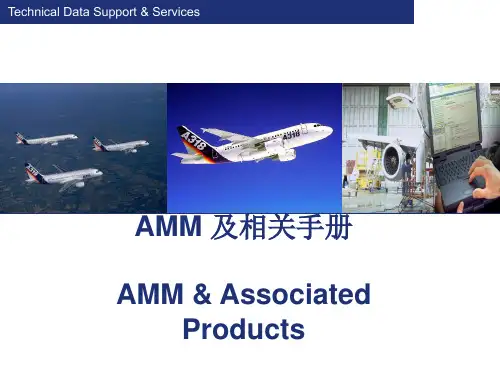
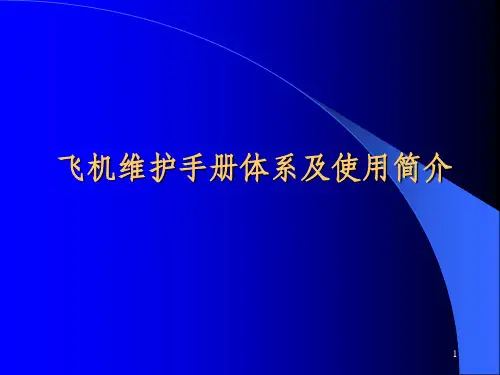


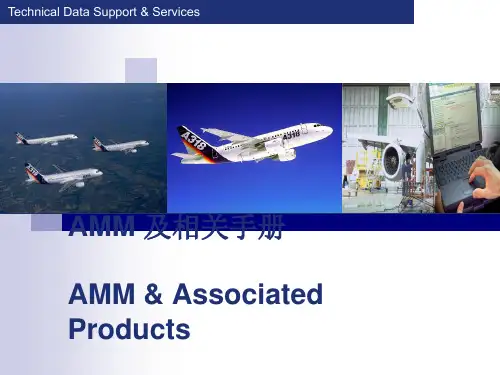
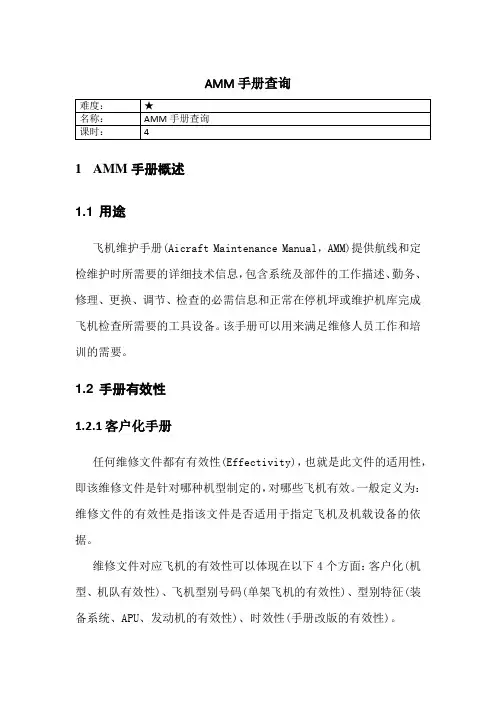
AMM手册查询1AMM手册概述1.1 用途飞机维护手册(Aicraft Maintenance Manual,AMM)提供航线和定检维护时所需要的详细技术信息,包含系统及部件的工作描述、勤务、修理、更换、调节、检查的必需信息和正常在停机坪或维护机库完成飞机检查所需要的工具设备。
该手册可以用来满足维修人员工作和培训的需要。
1.2 手册有效性1.2.1客户化手册任何维修文件都有有效性(Effectivity),也就是此文件的适用性,即该维修文件是针对哪种机型制定的,对哪些飞机有效。
一般定义为:维修文件的有效性是指该文件是否适用于指定飞机及机载设备的依据。
维修文件对应飞机的有效性可以体现在以下4个方面:客户化(机型、机队有效性)、飞机型别号码(单架飞机的有效性)、型别特征(装备系统、APU、发动机的有效性)、时效性(手册改版的有效性)。
AMM手册为客户化的手册。
通过FSN(机队序列号)来确定有效性。
1.2.2飞机识别号一架飞机从设计、实验、成批的生产到投入运行,过程是非常复杂的,也是非常严谨的,每一个过程都会有一些代表该过程的编号,这些编号用以对机型进行识别,同时,也用来确定各类手册、服务通告、适航指令等的有效性。
在各手册前言都有飞机有效性对照表,以方便用户查询手册时了解手册有效性。
1.2.3空客飞机有效性对照表A.机队序列号(Fleet Serial Number,FSN) 航空公司机队的飞机按照顺序编号,如:001、002。
B.飞机构型(Version Rank) 如:G8E01 0010、G8E01 0011。
C.飞机型号(Model) 如:320-214。
D.厂家序列号(Manufacturer Serial Number,MSN) 某一机型持续生产的编号,如:0772、0799。
E.注册登记号(Registration)如:B-2360、B-2361。
1.2.4手册修订AMM手册修订分为:定期修订临时修订TR临时修订的内容包含在List of Effective TemporaryRevisions(LETR)中,客户可以通过Airbus-World 和CD的形式获得最新的临时修订,在收到临时修订后应尽快将其上传至AirNav/Maintenance中。
![AMM手册的使用[1]](https://uimg.taocdn.com/35a670c39ec3d5bbfd0a74ac.webp)
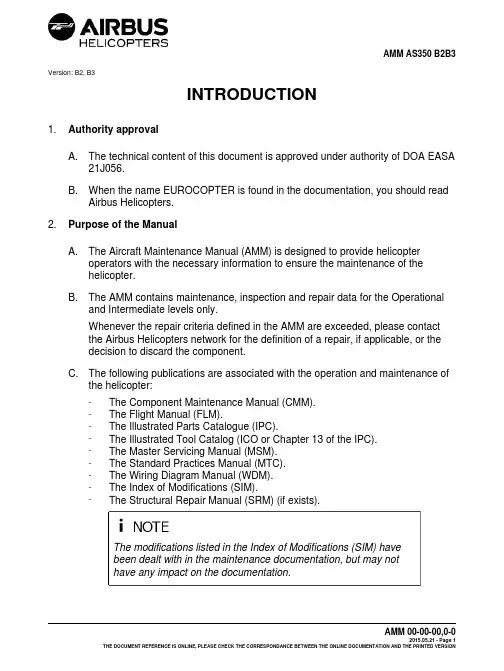
Version: B2, B3INTRODUCTION1.Authority approvalA.The technical content of this document is approved under authority of DOA EASA21J056.B.When the name EUROCOPTER is found in the documentation, you should readAirbus Helicopters.2.Purpose of the ManualA.The Aircraft Maintenance Manual (AMM) is designed to provide helicopteroperators with the necessary information to ensure the maintenance of thehelicopter.B.The AMM contains maintenance, inspection and repair data for the Operationaland Intermediate levels only.Whenever the repair criteria defined in the AMM are exceeded, please contactthe Airbus Helicopters network for the definition of a repair, if applicable, or thedecision to discard the component.C.The following publications are associated with the operation and maintenance ofthe helicopter:-The Component Maintenance Manual (CMM).-The Flight Manual (FLM).-The Illustrated Parts Catalogue (IPC).-The Illustrated Tool Catalog (ICO or Chapter 13 of the IPC).-The Master Servicing Manual (MSM).-The Standard Practices Manual (MTC).-The Wiring Diagram Manual (WDM).-The Index of Modifications (SIM).-The Structural Repair Manual (SRM) (if exists).The modifications listed in the Index of Modifications (SIM) havebeen dealt with in the maintenance documentation, but may nothave any impact on the documentation.In addition to the AMM, the corresponding engine publications (EMM) areprovided with each helicopter delivered.(1)Identification: Information for warehouse staff-Illustrated Parts Catalog (IPC)-Illustrated Tool Catalog (ICO or Chapter 13 of the IPC)(2)Special: Time-sensitive information-Service Bulletin (SB)-Alert Service Bulletin (ASB)3.Definition of required maintenance levels for application of the repairsThe various maintenance tasks are classified in levels so as to take into account the complexity of the tasks, the place of execution of the operations, the equipment and the training of the personnel.For structural repair requirements, these levels are defined by the letters "O", "I", "I+"and "D":-“O” LEVEL (Operation Level): This refers to implementation of simple structural repairs, carried out during line maintenance by the crew and/or line mechanicsusing limited equipment, in order to maintain the operational capability of theaircraft.-“I” LEVEL (Intermediate level): This refers to implementation of small repairs on or out of the aircraft, in a repair workshop using fixed facilities, by skilled,trained and qualified personnel, in order to restore the operational capability ofthe aircraft or equipment.For the "O" and "I" levels, repairs may be carried out in accordancewith the instructions of Airbus Helicopters publications: AMM /SRM / MTC.The rules defined for the "O" level are applicable to the "I" level.-“I+” LEVEL: This refers to implementation of repairs on the primary structure or on stressed composite parts, with the approval of the Airbus HelicoptersTechnical Support Department,. In a Repair Center mandatorily approved by Airbus Helicopters,. Or with mandatory Technical Assistance from Airbus Helicopters if the work iscarried out of an Airbus Helicopters Approved Repair Center,. Or with the assistance of an Airbus Helicopters Approved Repair Center if the work is performed out of an Airbus Helicopters Approved Repair Center.“I+” level repairs require approval from the Airbus HelicoptersTechnical Support Department. The repair work must be approvedby Airbus Helicopters ("I+" specific maintenance documentation, orspecific repair sheet submitted to Airbus Helicopters for approval),or transmitted to Airbus Helicopters if already approved by thesupervisory authorities of the repair workshop. The "I+" level workcards are identified in the work card title.The rules defined for the "I" level are applicable to the "I+" level.-"D" LEVEL: This corresponds to repairs which affect the interchangeability of major structural couplings or the general geometry of the aircraft, using toolingwhich ensures interchangeability, by a maintenance center and specialists dulyqualified by Airbus Helicopters.The supply of documentation (SRMD), tooling and "D" level spareparts is reserved for "D" level Maintenance Centers qualified byAirbus Helicopters.An aircraft cannot be reconstituted using the identification plateof an aircraft which has been declared scrapped by AirbusHelicopters without the prior written approval of Airbus Helicopters.The rules defined for the "I+" level are applicable to the "D" level.Airbus Helicopters reminds you that it is forbidden to reuse structural parts orassemblies which have been involved in an accident without prior approval from the Airbus Helicopters Technical Support Department.The major structural couplings are the following:Landing gear attachment points, MGB bar attachments, attachment points ontransmission deck, engine mount attachment points, fuselage/tail boom junction,horizontal stabilizer-Fenestron junction and TGB attachment points.4.Following up the technical publicationsA.The manuals are valid only if they are regularly kept up to date by the users.The Updating department is governed by the “General Terms and Conditions ofSale” appended to any contract.Documentation may be distributed in three formats: Paper/DVD/PDF (e-techpub).B.Advice to operatorsPaper manuals that have not been kept up to date must not be used forhelicopter maintenance. They must be destroyed on the spot or clearly marked“documentation not up to date”.DVDs must be replaced when each new revision is issued. A DVD that pre-datesthe latest revision must not be used for helicopter maintenance.The e-techpub documentation is updated directly on the Internet.5.Updating the manualA.Normal Revision (NR)Paper issue:-The Maintenance Manuals are updated by a regular updating system. The revision completely or partially updates the manual. The revisions are issuedwith the modification instructions (Highlights).The user or operator is responsible for ensuring that only the correct issueof the manual is used. The effectivity of the manual is indicated on the titlepage.-All the modifications (new, canceled or superseded pages) made to the manuals must be incorporated and recorded in the update list.-Follow the Highlights: these will ensure that the manual is compliant with its new composition, each chapter complying with its own list of effective pages(LOEDU).-The modifications are identified as follows:. All modifications to, additions to or deletions from a text or modifications toa figure are indicated by a black line in the margin.. If part of the text is relocated this may result in changes to the numbering ofthe pages, tables or figures but these changes are not indicated.. All the pages of a modified page block show the modification date.PDF issue:-The Maintenance Manuals are updated by a regular updating system. The revision completely or partially updates the manual. The revisions are issuedwith the modification instructions (Highlights).The user or operator is responsible for ensuring that only the correct issueof the manual is used. The effectivity of the manual is indicated on the titlepage.-The modifications are identified as follows:. All modifications to, additions to or deletions from a text or modifications toa figure are indicated by a black line in the margin.. If part of the text is relocated this may result in changes to the numbering ofthe pages, tables or figures but these changes are not indicated.. All the pages of a modified page block show the modification date.DVD issue:-The Maintenance Manuals are updated by a regular updating system. The revision completely or partially updates the manual. The revisions are issuedwith the modification instructions (Highlights).The user or operator is responsible for ensuring that only the correct issue ofthe manual is used. The effectivity of the manual is given by the "LOIM" (listof manuals included in the DVD-ROM).. If part of the text is relocated this may result in changes to the numbering ofthe pages, tables or figures but these changes are not indicated.. All the pages of a modified page block show the modification date.6.Temporary Revision (TR)A.GeneralBetween two Normal Revisions, Airbus Helicopters may need to makemodifications to points of the manual considered important; this will be donethrough temporary revisions. The Temporary Revision deals with informationwhich requires quick distribution and which cannot wait until the next normalrevision is issued.Several Temporary Revisions may be issued between two Normal Revisions.The new, revised or deleted Documentary Units (DU) are issued on yellow colorpaper. The changes are indicated by a vertical line in the margin.Temporary Revisions are identified by the number of the next Normal Revisionfollowed by a letter (taken in alphabetical order) and a date code.position and updatingThe Temporary Revision is composed of an "Update instructions" section, a Listof Effective Pages of the Temporary Revision, one (or several) List(s) of EffectivePages for the chapter(s) and one (or several) Documentary Unit(s).The "Update instructions" section gives a list of the highlights of the TemporaryRevision. This information is issued with each new Temporary Revision (TR).The List of Effective Pages of the Temporary Revision (LOEDU-TR) identifiesthe chapters modified by all the Temporary Revisions. The date code associatedwith the Documentary Unit corresponds to the date of the Temporary Revision at which it was modified. This list is issued with each new Temporary Revision and supersedes the previous one. It must be inserted at the beginning of the manual in the preliminary Documentary Units and kept until the next Normal Revision (RN).The List of Effective Pages of the chapters "XX-LOEDU-TR" identifies the new, revised or deleted Documentary Units of the chapters affected by the Temporary Revisions. The date code associated with the chapter corresponds to the date of the TR at which it was modified. Only the List of Effective Pages of the modified chapters are issued. These lists must be inserted at the beginning of the chapters concerned and they cancel and supersede the previous ones. They must be retained until the next RN.New, revised or deleted Documentary Units:-For a new Documentary Unit: the new yellow-colored Documentary Unit must be inserted directly in the manual.-For a revised Documentary Unit: all the pages of the yellow-colored revised Documentary Unit cancel and supersede all the pages of the white-colored Documentary Unit concerned. This white-colored Documentary Unit must be removed from the manual.-For a deleted Documentary Unit: only the first page of the Documentary Unit that must be removed is issued on yellow-colored paper through theTemporary Revision. This page bears the word "DELETED". It cancels and supersedes all the pages of the white-colored Documentary Unit concerned.This white-colored Documentary Unit must be removed from the manual.ALL TEMPORARY REVISIONS INCORPORATED INTOTHE MANUAL MUST BE RECORDED IN THE RECORD OFTEMPORARY REVISIONS.PDF issue:The Temporary Revision is composed of "Highlights", a List of Effective Pages of the Temporary Revision, one (or several) List(s) of Effective Pages and one (or several) Documentary Unit(s).The "Highlights" list the major points of the Temporary Revision. This information is issued with each new Temporary Revision.The List of Effective Pages of the Temporary Revision (LOEDU-TR) identifiesthe chapters modified by all the Temporary Revisions. The date code associated with the Documentary Unit corresponds to the date of the Temporary Revision at which it was modified. This list is issued with each new Temporary Revision andsupersedes the previous one. It must be inserted at the beginning of the manualin the preliminary Documentary Units and kept until the next NR.The List of Effective Pages of the chapters "LOEDU-TR" identifies the new,revised or deleted Documentary Units of the chapters affected by the TemporaryRevisions. The date code associated with the chapter corresponds to the date ofthe TR at which it was modified. Only the List of Effective Pages of the modifiedchapters are issued.DVD issue:The Temporary Revision is composed of "Highlights" and one (or several)Documentary Unit(s).The "Highlights" list the major points of the Temporary Revision. This informationis issued with each new Temporary Revision.The "Highlights" of the Temporary Revision identifies the DUs modified by all ofthe Temporary Revisions. The date code associated with the Documentary Unitcorresponds to the date of the Temporary Revision at which it was modified. Thislist is issued with each new Temporary Revision and supersedes the previousone. The manual revision date code is indicated in the "LOIM".ALL TEMPORARY REVISIONS INCORPORATED IN THEMANUAL MUST BE RECORDED IN THE RECORD OFTEMPORARY REVISIONS.7.ErratumThis procedure is used to correct composition errors that do not in any way affect the technical data involving flight safety and the certification of the aircraft. This procedure is used to correct these errors rapidly and is completely separated from the revisions.The date code marked on the replacement page is underlined but it remainsunchanged.Consequently, the page enclosed with the erratum page must replace the pageissued previously.8.PreprintPreprint is a preliminary edition, which is used to transmit an update of the technical documentation in advance of the normal process of management and publication of the information.This procedure is used:-to reply to a customer after he has reported irregularities that require changes to the technical publications,-to introduce new parts and/or systems not included as part of technical publications supplied by Airbus Helicopters.Airbus Helicopters approves the contents of the data transmitted by Preprint.For the approved parts (certification), no page can be sent beforeapproval is granted by the authorities.Rules for the Preprint diffusion process:-The Documentary Units are printed on salmon-colored paper.-The Documentary Units bear the word "PREPRINT" in the diagonal.-The Documentary Units are identified by a new date code.-The Documentary Units must be inserted in place of the modified Documentary Units.Airbus Helicopters preferably transmits the Preprints electronically.In any case no preliminary edition will remain as is. It will always be followed bythe standard procedure of revision (TR and RN). The DUs must be removed by the customer upon receipt of the corresponding DU TR and/or DU RN which take into account the modifications transmitted through Preprint.position of the manualThe Aircraft Maintenance Manual (AMM) is made up of two parts:-Part I of the manual contains all the descriptive type data for all the systems. This Part I is called Systems Description Section (SDS). It is physically separated from Part II and is totally self-contained.-Part II contains the data required for the maintenance and fault isolation operations and procedures.10.Structure of the manualThe AMM is broken down into several levels in accordance with the ATA Specification No.100, Revision 31, with a "Chapter - Section - Subject" numbering system that uses six digits.11.Structure pagesThe AMM contains a series of pages called "Structure pages". They contain general instructions and/or guidelines to find the information.The structure pages contained in the AMM are as follows:-Update instructions.-Title page.-Record of temporary revisions.-List of effective pages of the manual.-Introduction.-List of Service Bulletins.-List of chapters.12.Chapter structure pagesEach chapter starts with a List of Effective Pages of the Documentary Units (LOEDU).This list gives the aircraft version or aircraft serial number effectivity of eachDocumentary Unit.13.Breakdown into chaptersThe manual is broken down into chapters, in accordance with the ATA 100Specification.The chapter below was added:Chapter 01:-List of Materials (in AMM Part II).-List of Critical Parts (depending on aircraft).The numbering principle for the Manual is a breakdown into Chapter - Section -Subject, in a digital form:-the first three digits are given by the ATA 100 SpecificationExample: 62-2x-yz62-2 Main Rotor (system)-the last three digits are left at the manufacturer's disposal:. digit x to complete a sub-system number,. digits yz to complete a sub-sub-system number.Example: 62-2x-yz62-21 Main Rotor Hub (sub-system)62-21-11 Spring vibration damper (sub-sub-system)14.Chapter breakdown into topics (SDS section)Inside the chapters of the manual, the subjects are broken down into topics which gather tasks depending on the maintenance operations.The System Description Section gives explanations on the location, use, description and operation of the complete system and its sub-systems.This section is designed so that it can be used as a training manual.The identification comes in the form of a series of Documentary Units (DU).There are two title levels:-The higher level represents a set of information of the same type (e.g.: General, General Description, Detailed Description, etc.). All the illustrations of a"Documentary Unit" are grouped at the end of this Documentary Unit.Each UD is broken down into subsets.These subsets represent a group of paragraphs.Each subset begins with a title (Introduction, Description, Characteristics,Operation, etc.).15.Chapter breakdown into topics (AMM section)A.Fault IsolationThis section gives the information for the ground maintenance teams to locatefailures and faulty operation and to determine the necessary corrective actions.This topic comes in the form of a table:-The first column "Failure Indication" gives a detailed description of the fault.-The second column "Probable Cause" lists the possible causes of the fault, in the logical fault isolation order.-The third column "Corrective action" indicates the action(s) to be taken to correct each possible cause of the failures listed.B.Maintenance tasksThese topics describe the processes which allow the ground maintenancepersonnel to carry out the maintenance, removal/installation, adjustment, checkoperations, etc.When the task is given for reference, the Chapter - Section - Subject number is followed by the task number:Example: 62-21-00, 4-1 Removal - Main rotor hubIf an instruction requires the execution of a task, its reference number appears between brackets at the end of the instruction.Example: Remove main rotor hub (62-21-00, 4-1).Depending on aircraft configuration, the reference number of the task may be preceded by a configuration number. The selection of this configuration number is the responsibility of the operator.ex: conf 001 62-21-00, 4-1,ex: conf 002 62-21-00, 4-1Further to changes in aircraft configuration, compliance with a Service Bulletin, change of component part number ("Manufacturer Part Number") or a series production modification, the maintenance task can be followed by a configuration letter. The selection of the configuration letter is the responsibility of the operator. Example: 62-21-00, 4-1a Removal - Main rotor hub (PRE MOD 07xxxx) Example: 62-21-00, 4-1b Removal - Main rotor hub (POST MOD 07xxxx)Each task contains the information below:-List of Applicable Documents1. Main informationContains references to other tasks that are essential to carry out theprocedure.2. Conditional informationContains references to other tasks the application of which in the procedure depends on the maintenance environment, the choice or skills of thecustomer.3. General informationContains references to other tasks containing information that is supposedly known by the operator, as well as the code of the manual(s) where suchinformation can be found.-List of special toolsThis is the list of the special tools required to carry out the Task. These "special" tools are those that are not normally available to the maintenance personnel. These tools are identified with their "part numbers" and descriptions.These special tools are listed in the ICO (or in Chapter 13 of the IPC).Certain tools (not listed in the ICO (or in Chapter 13 of the IPC) and not normally available to the maintenance teams) are identified by the term "Commercial" to indicate that they are purchased "off the shelf".-List of MaterialsThis is the list of the consumable materials required to carry out the Task. They are identified with a "CM" code and their description.Details of the products that correspond to these codes are given in W.C.20-01-01-102 of manual MTC.The 20-01-01-102 of MTC describes the "NATO" code, the different references of the French, German and US Specifications and the list of the source products. It also refers to the implementation procedures described in the Standard Practices Manual (MTC) for certain products.Certain materials are identified by the term "Commercial". This means that they can be purchased off the shelf.-List of Routine Replacement PartsThis is the list of the parts discarded and replaced during a Task.This list comes in the form of a table:-the first and second columns give the position of the part (text/figure/set),-the third column gives the name of the part,-the fourth column gives the part number (MP/N).-Job Set-up (optional)This topic specifies how to prepare the helicopter for the work to be done.-ProcedureThe procedure is described in the form of a logical sequence of phases, broken down as follows:(1) phase(a) sub-phase of (1)1 sub-phase of (a)a sub-phase of 1The figures and tables are numbered in chronological order so that they can be used for several phases inside the same Task.All the figures inside a Task are gathered at the end of the Task.The items are identified in a continuous ascending order starting with Item 1 on Set 1 and finishing with Item n on Set m. If a part appears on several figures/sets, it shall always have the same item number.Figure 401 is the first figure in a "Removal / Installation" topic.Table 602 is the second table in an "Inspection / Check" topic.A figure can include several sets. In this case, the figure number remains the same, and only the set number is changed.Furthermore, the items are defined on all the sets of the figure.Figure 401 (Sheet 1)Figure 401 (Sheet 2)If there are no specific indications of the tightening torques onthe figures, then the tightening torque values are the Standardtorque values. To determine this standard value, refer to (MTC20-02-05-404).-Special NotesUSED TO EMPHASIZE A MAINTENANCE OPERATION ORPRACTICE, A CONDITION, A STATEMENT, WICH IF IT IS NOTSTRICTLY RESPECTED MAY CAUSE SERIOUS INJURY ORDEATH.USED TO EMPHASIZE A MAINTENANCE OPERATION ORPRACTICE, A CONDITION, A STATEMENT, WICH IF IT IS NOTSTRICTLY RESPECTED MAY DAMAGE OR DESTROY ANEQUIPMENT ITEM OR PREVENT FULL COMPLETION OF THEMISSION.Used to emphasize an operation or a condition that with help thepersonnel or simplify a maintenance procedure.-Close-up (optional)This topic specifies how to return the helicopter to its initial configuration (asbefore the maintenance operation).16.SymbologyAll the symbols used in the maintenance publications (SDS and AMM Part II) are explained in the following table.17.List of AbbreviationsAFNOR: Association Française de Normalisation (French Industrial Standards Association)ALL P/N: All part numbersAMM: Aircraft Maintenance ManualASU: Ancillary System UnitCBP: Circuit-Breaker PanelCHK: Condition Check - Airworthiness limitationCM: MaterialCMM: Component Maintenance ManualCSS: Chapter - Section - SubjectD: DayDC: Direct CurrentE: Maintenance Due TimeEASA: European Aviation Safety AgencyELT: Emergency Locator TransmitterEMB: Electrical Master BoxEMM: Engine Maintenance ManualESD: Electrostatic Discharge Sensitive DeviceFC: Functional Check (quantitative)FLM: Flight ManualFM: Log cardH: HourHP: High PressureHT: Hard TimeHz: HertzICS: Intercommunication SystemIGE: In Ground EffectIPL: First Limitation IndicationLACU: Lighting and Ancillaries Control Unit LED: Light-Emitting DiodeLH: LeftLP: Low pressureM: MonthMOD 07 xxxx: ModificationMOD AL xxxx: Minor (simplified) modification MOD OP xxxx: Modification of optional equipment MGB: Main GearboxMP/N: Manufacturer's Part NumberMRH: Main Rotor HubND: Not DescribedNF: Free Turbine rpmNR: Rotor rpmOAT: Outside Air TemperatureOC: On Condition (check, maintenance)OGE: Out of Ground EffectOPT: OptionalOTL: Operating Time LimitPCB: Printed Circuit BoardPTT: Push To TalkRH: RightSDS: System Description SectionSLL: Service Life LimitS/N: Serial NumberSP: Static PressureTBD: To Be DefinedTBO: Time Between OverhaulsTGB: Tail GearboxTP: Total PressureTRH: Tail Rotor HubTSI: Time Since InstallationTSM: Time Since ManufactureU: Operating CycleVEMD: Vehicle & Engine Multifunction DisplayW: WeekWDM: Wiring Diagram ManualY: Year18.GlossaryATTACHMENTThe visual check is carried out on the attachment points of a component (condition of the safetying, marks on self-locking nuts). It may be necessary to complete this examination with a tactile check (manual application of a load on the component to detect any fault in the assembly).CHECKA check consists in comparing the measurement of a magnitude (force, time,pressure, temperature, length, etc.) with a theoretical value. The resulting actionconsists in bringing back this magnitude to a value that ranges within its tolerances, through adjustment or a maintenance action (e.g.: check of tightening torques, check of play, etc.).CLEANLINESSThe cleanliness check consists in making sure that there is no foreign matter, no fluid seepage or splashes and no "fouled" areas likely to conceal a fault.CONDITIONThe visual examination concerns the general external condition of a component and the points that could modify its initial condition (deformation, breaks, cracks, scores, corrosion, signs of overheating or wear).。
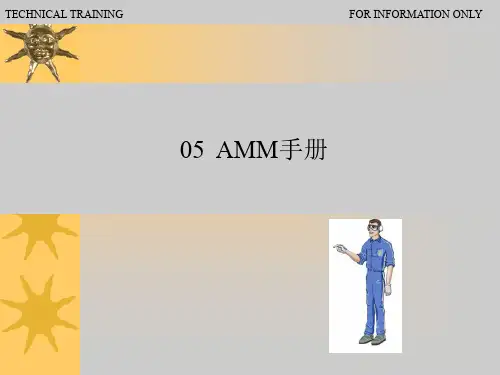
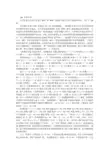
AMM 手册介绍介绍主要以空客手册为主,MD82 和 MD90 飞机的手册与空客手册基本内容一致。
1. 概述飞机维护手册(AMM)是按照 ATA 100 规范编制的。
飞机维护手册含有正常在停机坪或者在维护机库中完成的,对飞机设备和系统的保养,修理,调节,检验和检查所需信息。
飞机以外设备所需的信息包含在厂家或者制造厂的部件维护手册中。
飞机维护手册也含有关于飞机结构的检查和维护的信息。
当然,结构的修理包含在结构修理手册或短舱结构修理手册内。
用于排除故障所必需的信息被包含在排故手册中。
飞机维护手册含有完成维护评审委员会(MRB)文件和相应维护计划资料(MPD)规定的定期维护程序所必要的数据。
手册中使用公制和非-公制测量系统。
在原来的参考文件里使用的度量衡单位数值先列出,然后在括号中换算成另一单位的量值。
客户代码和修订日期出现在每页的底部,修订日期可以是原版日期,修订日期或者最新版日期。
2. 手册划分飞机维护手册分成各章节飞机概述章时限/维护检查...... 5 尺寸和区域...... 6 顶起与支撑...... 7 校水平和称重...... 8 牵引和滑行...... 9 停放和系留 (10)铭牌和标志...... 11 勤务...... 12 飞机机体系统标准实施-机身...... 20 空调 (21)自动飞行...... 22 通讯...... 23 电源...... 24 设备/装饰...... 25 防火...... 26 飞行操纵...... 27 燃油...... 28 液压源...... 29 防冰和防雨...... 30 指示/记录系统...... 31 起落架...... 32 灯...... 33 导航系统...... 34 氧气...... 35 气动系统...... 36 水/废水 (38)机载辅助电源...... 49 结构结构 (51)舱门...... 52 机身...... 53 短舱/吊架...... 54 安定面...... 55 窗...... 56 机翼 (57)动力装置标准实施-发动机…… 70 动力装置…… 71 发动机…… 72 发动机燃油和控制…… 73 点火…… 74 空气…… 75 发动机操纵…… 76 发动机指示………… 77 排气…… 78 滑油…… 79 起动…… 80 2.1 章节划分规则每个章/系统细分成节/子系统(结合功能/自然组)。
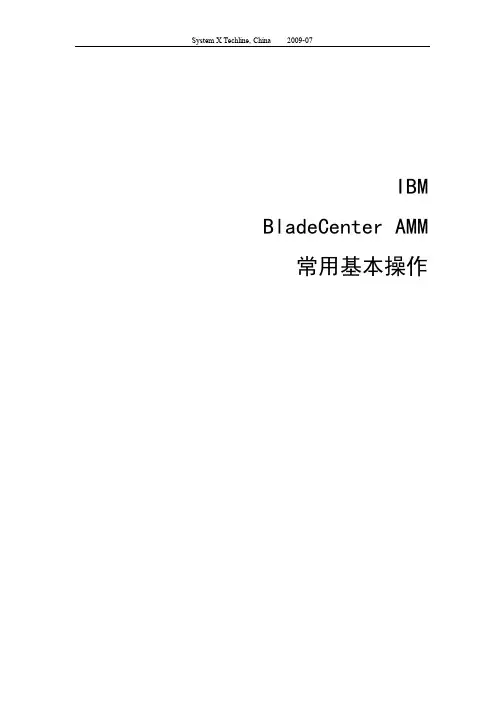
I B M B l a d e C e n t e r A M M常用基本操作一.登录AMM (3)二.开启I/O模块外部端口 (3)三.登录I/O模块配置界面(Telnet或Web界面) (4)四.打开Remote Control界面 (6)五.查看I/O模块等的VPD信息 (8)六.查看如刀片服务器等部件的Firmware信息 (9)导读:本文仅对几个常用入门操作进行简单说明。
如果您初次接触A M M,并且上述目录中列出的几个操作您又需要使用,请参考。
如果您经常接触A M M或是资深的系统管理员,本文对您没有技术上的提高以及深入的帮助。
如有深入的需求,请参考A M M用户手册。
A M M常用基本操作(注:本文适用于A M M,但由于微码版本区别界面可能会稍有不同)一.登录AMM在浏览器地址栏中输入A M M的I P地址,(默认为192.168.70.125)会打开如下图登录界面,输入用户名(U s e r I D)和密码(P a s s w o r d)。
(默认用户名为U S E R I D,密码P A S S W0R D,其中0是数字0。
)二.开启I/O模块外部端口默认情况下,I/O模块外部端口为D i s a b l e状态,即外部端口不可用。
在左侧导航栏中选择I/O M o d u l e T a s k s下的A d m i n/P o w e r/R e s t a r t选项,打开如下图所示界面。
在右侧主界面的I/O M o d u l e A d v a n c e d S e t u p下选择需要操作的I/O模块(S e l e c t a m o d u l e)然后选择E x t e r n a l P o r t s为E n a b l e d,点击右下的S a v e按钮保存。
三.登录I/O模块配置界面(Telnet或Web界面)如果要对I/O模块如以太网交换模块进行配置,可以选择I/O M o d u l e T a s k s选项下的C o n f i g u r a t i o n菜单,会打开如下图界面。